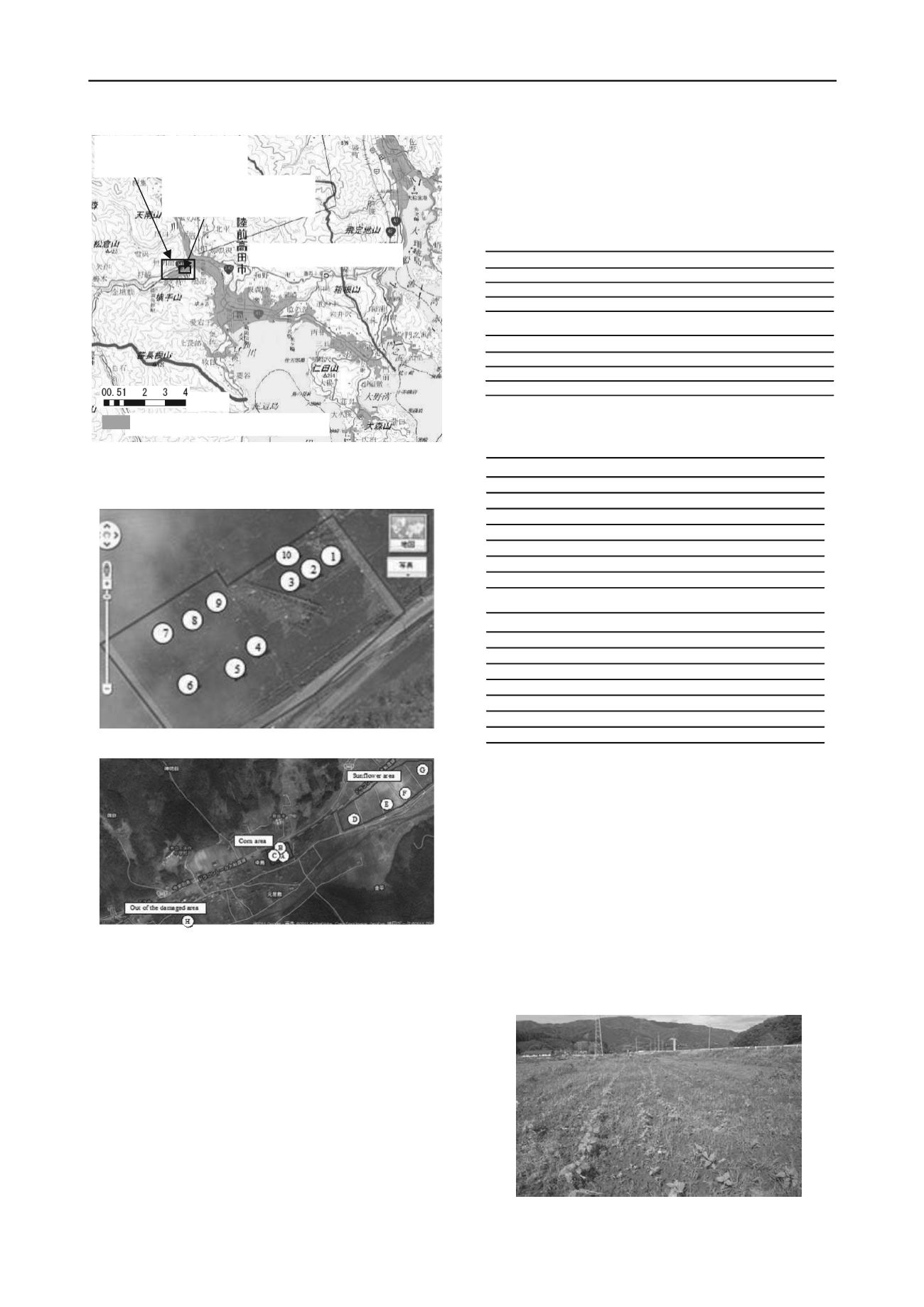
3058
Proceedings of the 18
th
International Conference on Soil Mechanics and Geotechnical Engineering, Paris 2013
Figure 1. The damaged area in Rikuzentakata city of Iwate Prefecture
(The
Geospatial
Information
Authority
of
Japan,
)
Figure 2. The place of investigation on 5 May 2011
Figure 3. The place of investigation on 30 June 2011
one of the major affected areas by the tsunami on 11 March
2011. Figure 2 shows the place of soil investigation on 5 May
2011 and Fig. 3 shows the place of investigation on 30 June
2011. The sampling area shown in Fig. 1 corresponds to No. F
in Fig. 2.
The pH and electric conductivity (EC) of the damaged
agricultural land were measured by a digital pH meter (Horiba,
D-54SE). The EC of the soil was also measured by using digital
an EC meter (Oakton, PCSTEST35). The salinity of the soil
was calculated from EC. It is said that normal plants are
affected by salt if soil EC exceeds 0.3-0.7 mS/cm. Some parts
of the land showed very high EC on 5 May 2011. Table 1 shows
the test result of EC and pH. There is the following empirical
relationship between Cl (Chlorine) and EC;
Cl content (mg/100g) = EC(mS/cm)×166
The investigation on 30 June 2011 was done in a wide area
including the place investigated on 5 March 2011. Table 2
shows the test result of EC and pH. In Fig. 3, No. A~C is corn
area, No. D~G is sunflower area and No. H is out of damaged
area. The ECs of several soils were low, possibly due to the
start of rainy season. Some soils however still showed high EC.
Table 1. Electrical conductivity (EC) and pH of the soils measured on 5
May 2011
Depth 1 2 3 4 5 6 7 8 9 10
5cm 1.51 0.36 0.39 1.49 1.26 0.47 1.20 1.77 1.01 0.25
10cm 3.04 2.00 1.94 2.93 3.16 1.32 2.77 3.43 1.83 1.15
15cm 2.23 2.43 2.81 4.03 2.21 1.84 0.97 3.46 2.4 2.25
Depth 1 2 3 4 5 6 7 8 9 10
5cm 7.21 8.47 8.06 7.55 7.22 8.39 7.71 7.62 7.19 8.27
10cm 5.75 5.68 6.5 5.78 5.71 6.57 5.98 5.6 6.74 6.52
15cm 6.22 5.48 5.69 5.2 6.13 5.84 7.12 5.64 5.77 5.82
(a) EC (mS/cm)
(b) pH
Table 2. Chemical properties of the soils (30th June, 2011)
Depth
A B C D E F G H
Surface
0.56 0.11 0.13 0.083 0.09 0.064 0.13 -
5 cm -
-
-
-
-
-
-
0.032
10 cm 0.97 1.19 0.62 -
0.093 0.15 -
-
15 cm -
-
-
-
-
-
0.21 -
20 cm 1.83 1.58 1.64 0.21 0.096 0.46
0.026
25 cm 2.15 -
-
-
-
-
-
-
30 cm -
-
1.65 -
-
-
-
-
Depth
A B C D E F G H
Surface
7.2 8.1 7.4 8.3 9.0 8.4 8.0 -
5 cm -
-
-
-
-
-
-
6.9
10 cm 6.6 5.9 6.7 -
9.1 8.4 -
-
15 cm -
-
-
-
-
-
6.7 -
20 cm 6.1 5.6 5.9 7.0 8.0 7.1 -
6.9
25 cm 6.4 -
-
-
-
-
-
-
30 cm -
-
5.7 -
-
-
-
-
(a) EC (mS/cm)
(b) pH
4 ATTEMPT OF RESTOATION OF AGRIGULTURAL
LAND
4.1
Methods of Restoration
The aim of soil salinity control is to prevent soil degradation by
salinization and to reclaim already degraded soils. Various
attempts are now being tested to control salinity of the
agricultural land.
The primary method of controlling soil salinity is to permit
10-20% of irrigation water to leach through the soil; the leached
water is then drained and discharged through an appropriate
drainage system. The salt concentration of the drainage water
normally becomes 5 to 10 times higher than that of the
Figure 4. Growing sunflower at the agricultural land
km
Submerged area by Tsunami
Rikuzentakata city
Investigation area
(5th March, 2011)
Investigation area
(30th Jume, 2011)


